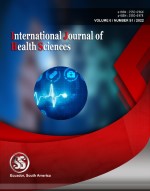Discrete wavelet transform based on EEG signal analysis for diagnosing neurological disorder
Keywords:
Artificial Neural Network, Discrete Wavelet Transform, Electro Encephalo Gram, Entropy, Epilepsy, K-Nearest Neighbour, Linear Discriminant Analysis, Support Vector MachineAbstract
ElectroEncephaloGram (EEG) signal analysis is critical since it is a reliable approach for detecting neurological brain diseases. In this work, the artifacts in the EEG dataset are removed using the Independent Component Analysis (ICA) technique. The EEG dataset was then filtered with a band-pass filter to eliminate noise. In this work using a Discrete Wavelet Transform (DWT) to deconstruct the filtered data, the EEG signal features are recovered. The features are also supplied into four separate classifiers. Five statistical techniques are utilised to extract characteristics from EEG sub bands: Local Binary Pattern (LBP), Standard Deviation (SD), Variance, Kurtosis, and Shannon Entropy (SE). To classify the features related to their classes Linear Discriminant Analysis (LDA), Support Vector Machine (SVM), K-Nearest Neighbour (KNN), and Artificial Neural Network (ANN) are four classifiers that use the features.The overall classification accuracy approaches 90.5% using SVM, 99% using ANN, 87.5% using LDA and 97% using KNN respectively. In this work ANN gives better performance accuracy than other classifers.
Downloads
References
Noachtar, S.; Rémi, J., 2009, The role of EEG in epilepsy: A critical review. Epilepsy Behav., 15, 22–33. [2]. Ocak, H., 2009, Automatic detection of epileptic seizures in EEG using discrete wavelet transform and approximate entropy. Expert Syst. Appl. 36.
Nunes, T.M.; Coelho, A.L.; Lima, C.A.; Papa, J.P.; De Albuquerque, V.H.C., 2014, EEG signal classification for epilepsy diagnosis via optimum path forest—A systematic assessment. Neurocomputing, 136, 103–12.
Subasi, A., . 2007 EEG signal classification using wavelet feature extraction and a mixture of expert model. Expert Syst. Appl, 32, 1084–1093.
Subasi, A.; Gursoy, M.I., 2010, EEG signal classification using PCA, ICA, LDA and support vector machines. Expert Syst. Appl.,37, 8659–8666.
Morabito, F.C.,2000, Independent component analysis and feature extraction for NDT data. Mater. Eval.,58, 85–92.
Yong, Y.; Hurley, N.; Silvestre, G.,2005, Single-trial EEG classification for brain-computer interface using wavelet decomposition. In Proceedings of the European Signal Processing Conference, Antalya, Turkey, 4–8. [8].
Patel, K.; Chua, C.P.; Fau, S.; Bleakley, C.J., 2009 Low power real-time seizure detection for ambulatory EEG. In Proceedings of the 3rd International Conference on Pervasive Computing Technologies for Healthcare,London, UK, 1–3.
Yuan, Q.; Zhou, W.; Liu, Y.; Wang, J., 2012, Epileptic seizure detection with linear and nonlinear features. Epilepsy Behav.,24, 415–421.
El Safty, S.; El-Zonkoly, A., 2009 Applying wavelet entropy principle in fault classification. Int. J. Electr. Power Energy Syst., 31, 604–607.
Shoeb, A., 2009 Application of Machine Learning to Epileptic, Seizure Onset Detection and Treatment. Ph.D. Thesis, Massachusetts Institute of Technology, Cambridge, MA, USA.
Sadati, N.; Mohseni, H.R.; Maghsoudi, A., 2006. Epileptic seizure detection using neural fuzzy networks. In Proceedings of the IEEE International Conference on Fuzzy Systems, Vancouver, BC, Canada, 16–21.
Published
How to Cite
Issue
Section
Copyright (c) 2022 International journal of health sciences

This work is licensed under a Creative Commons Attribution-NonCommercial-NoDerivatives 4.0 International License.
Articles published in the International Journal of Health Sciences (IJHS) are available under Creative Commons Attribution Non-Commercial No Derivatives Licence (CC BY-NC-ND 4.0). Authors retain copyright in their work and grant IJHS right of first publication under CC BY-NC-ND 4.0. Users have the right to read, download, copy, distribute, print, search, or link to the full texts of articles in this journal, and to use them for any other lawful purpose.
Articles published in IJHS can be copied, communicated and shared in their published form for non-commercial purposes provided full attribution is given to the author and the journal. Authors are able to enter into separate, additional contractual arrangements for the non-exclusive distribution of the journal's published version of the work (e.g., post it to an institutional repository or publish it in a book), with an acknowledgment of its initial publication in this journal.
This copyright notice applies to articles published in IJHS volumes 4 onwards. Please read about the copyright notices for previous volumes under Journal History.
















